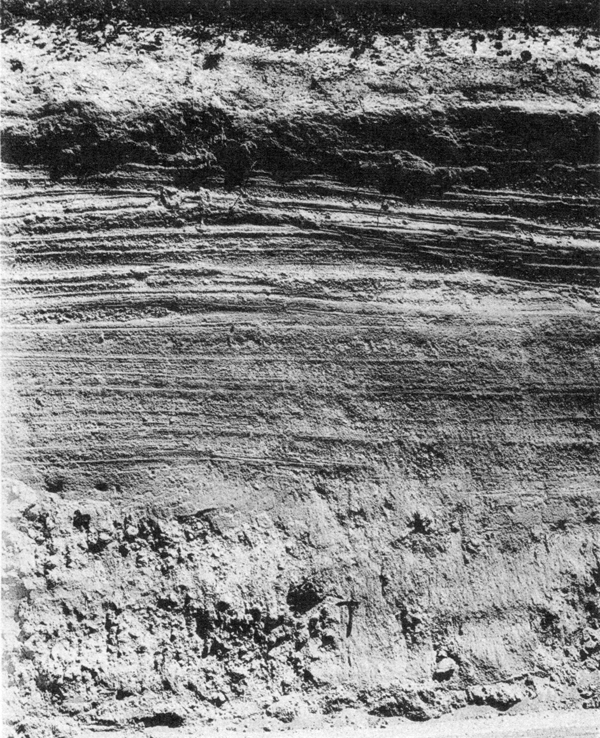The Geology of Crater Lake National Park, Oregon With a reconnaissance of the Cascade Range southward to Mount Shasta by Howell Williams
The Climax: Culminating Explosions of Pumice and Scoria
The Last Weak Explosions
After the pumice and scoria flows had been discharged, most of the energy of the volcano was spent. Nevertheless, enough gas remained in the magma chamber to cause a few dying explosions.
|
Plate 17. Fig. 3. Pumice deposits on Diamond Lake highway. At the base, 4 feet of coarse, unbedded pumice-flow deposits containing a charcoal log (near hammer). Above, bedded, fine pumice fall. The dark band near the top is the pink zone caused by oxidation of fumarolic gases rising from the pumice flow at the base. This indicates that the fine pumice fell on the flow while it was still hot. |
The concluding eruptions cannot have been violent, for the ejecta are fine and limited in distribution. Most of the material was blown above the vents and dispersed by winds, just as the initial deposits of pumice were scattered. But unlike the earlier pumice fall, the final fall contains few large lumps of pumice, and is much richer in both lithic fragments and crystals. Probably most of the pumice blown out by these last explosions represents material that fell back into the craters during the first explosions, to be hurled out a second time. Much of the ejecta consists of dark-brown and reddish crystal-rich scoria and small fragments of old lava. The high content of lithic detritus is only to be expected, for after the great pumice and scoria explosions the conduits must have been greatly enlarged and their walls must have been subject to inward slumping.
Most of the ejecta fell near the caldera rim, especially on the northeast side, where they form banks up to 50 feet in thickness. Some material was blown westward and may be seen resting on top of the pumice flows along the Rogue River (plate 17, figure 3). Compared with the earlier pumice falls, the youngest ash is much finer, better sorted, and richer in crystals and lithic fragments. Typical samples are represented by the histograms (figure 21, Rugged Crest; figure 25, no. 360; figure 26, nos. 230c, 36a).


